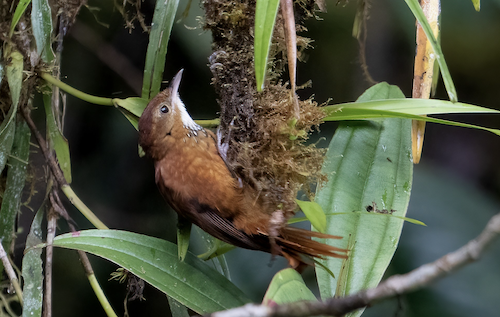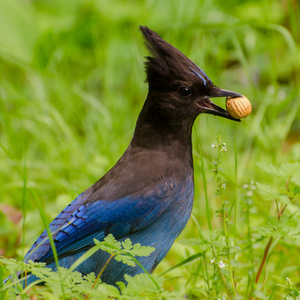When it comes to conserving biodiversity, particularly in the world’s tropical forests, simple geometry doesn’t cut it. A 100-acre block of forest may have the same area as ten, separate 10-acre blocks of forests, but it typically has higher overall biodiversity. Scientists and conservationists have understood for many years that fragmentation exacerbates the loss of species due to habitat loss. But why are smaller patches of habitat unsuitable for many forest species?

A Collared Inca, a nectar specialist that is sensitive to forest fragmentation. Photo by Dave Curtis.
It’s important to understand the “why,” or the mechanism, of a problem in order to effectively address it. Figuring out why an individual bird species cannot persist in a habitat fragment traditionally requires testing hypotheses using experimental manipulations in the field. But when it comes to conservation, we often don’t have the time or capacity to do field experiments on a species-by-species basis.
In a recent paper in the journal Biodiversity and Conservation, IBP ecologist Dr. Harry Jones and co-authors from the Universidad del Valle, the Universidad Nacional de Colombia, the Universidad Icesi, all in Colombia, as well as the University of Florida, explore why forest fragmentation leads to bird species loss in the cloud forest of the western Andes using a new approach focusing on “functional traits.” A functional trait is a characteristic of a species that determines how that species interacts with its environment. For bird species, functional traits can be behavioral characteristics, like where and how a species forages, or physical or physiological characteristics, like the size and shape of the wing.
The researchers investigated four major hypotheses that might explain why forest fragmentation leads to species loss among 178 Andean bird species by examining the relationship between 13 different functional traits and sensitivity to fragmentation. The first hypothesis–that fragmentation leads to the loss of food resources and foraging micro-habitats–was assessed by looking at relevant functional traits including diet specialization (i.e., reliance on insects, fruit, etc.), foraging maneuvers (e.g., gleaning, sallying) and use of specific micro-habitats (e.g.,. tree falls gaps, small streams, etc.) A second hypothesis was that species with limited ability to disperse (poor flight capacity, aversion to crossing gaps) are lost in fragmented forests because they cannot effectively cross non-forest habitat when moving to and from small fragment. To test this, the researchers focused on the species’ ‘hand-wing index’, which is a measure of the roundness or pointy-ness of wings. (Round stubby wings are not effective for longer distance flights, whereas pointier wings are.) The third hypothesis–that species inhabiting darker forest interior habitats are lost from brighter-lit forest fragments because they are sensitive to light–was examined by looking at relative eye size (larger eyes for a given body size are correlated with use of darker habitats.) And finally, the fourth hypothesis–that species are lost from forest fragments because they are more sensitive to the higher nest predation risk in those fragments–was assessed by looking at nest type (e.g.. cavity, open cup, etc.), clutch size, and generation length (species that start breeding at a younger age can reproduce faster than those that mature more slowly.)

A Fulvous-dotted Treerunner, an insectivore that specializes on foraging on epiphytes. Photo by Richard Eden/Macaulay Library ML411165701
Jones and colleagues did not find support for the dispersal limitation hypothesis, the idea that bird species that don’t typically fly long distances are lost from fragmented forests because they can’t or won’t fly across open habitat to colonize or disperse from small fragments. Across all of the species considered, there was no statistical relationship between hand-wing index and sensitivity to fragmentation, but when considering only insectivores there was a positive relationship, such that insect-eating species with more pointed wings were more sensitive to fragmentation. This is the opposite of the relationship predicted by the dispersal limitation hypothesis.
However, the researchers did find support for the three other hypotheses. Species with more specialized diets were significantly more sensitive to fragmentation, as were species that used canopy and sub-canopy microhabitats. These results support the hypothesis that loss of food resources and foraging micro-habitats leads to loss of species from forest fragments. Jones and colleagues give the example of insectivores that specialize in foraging on epiphytic plants, such as the Fulvous-dotted Treerunner, Margarornis stellatus. Epiphytic plants are most abundant in the subcanopy and typically less abundant in forest fragments, especially near the edges. So when forests are fragmented, there is less foraging microhabitat- in this case, epiphytic plants- for these specialized species.

A Rufous-breasted Antthrush, one of the large-eyed species in this study. Photo by Brendan Rush.
Jones and colleagues found support for the light sensitivity hypothesis. Species with larger eyes relative to their bodies, such as owls, antpittas, thrushes, and quetzals, were more sensitive to fragmentation than species with smaller eyes. Larger eyes are typically found in species that primarily use low-light habitats because a bigger eye can allow in more light, which improves vision in dim conditions. However larger eyes may let in too much light in bright conditions that are more typical of open habitats. Forest fragments usually have brighter interior light conditions than larger patches because more light can penetrate through canopy gaps and from the edges of the fragments. These species may also be less likely to disperse across brightly lit gaps between forest fragments.
And lastly the researchers found some evidence that species that are more sensitive to nest predation risk were also more sensitive to forest fragmentation. Species with larger clutches, including toucanets and Green Jay, were less sensitive to forest fragmentation, however there was no relationship between fragmentation sensitivity and nest type or generation length. Larger clutch sizes are thought to be a buffer against nest predation risk because when successful, a bird with a clutch of, say, 6 eggs produces many more offspring than a bird with a clutch of 2 eggs. Nest predation risk is thought to be higher in forest fragments because populations of meso-predators such as tayras, raccoons and agouti are typically higher in these habitats.

Crimson-rumped Toucanets have relatively large clutch sizes and may be less sensitive to nest predation.
This study not only highlights the need to avoid forest fragmentation and preserve large patches of late successional forest for conserving bird biodiversity in the Andean cloud forest, it also gives scientists and land managers better insight into why fragmentation makes forests unsuitable for certain species. This knowledge will allow better predictions as to which species will be affected by fragmentation and help inform potential management strategies to mitigate fragmentation’s effects when it does occur.
This Andean cloud forest study was part of Jones’s dissertation research; his current work with IBP, studying bird populations in the national parks of the Southern Colorado Plateau in the US Southwest, takes place in a very different landscape. And because these study areas are protected parks, habitat fragmentation isn’t a major issue. Nevertheless, analysis of functional traits can be used to better understand the mechanisms behind other processes affecting bird populations in these parks, such as wildfire, climate change, and drought. The technique may hold promise, for example, to help understand concerning declines of mixed-conifer forest bird species like Mountain Chickadees at Grand Canyon NP and Bandelier NM. “I think focusing on mechanisms is really important, because when you're doing work on population trends, you can say, it's going up, it's going down, or it's not changing. But then often we want to know why is that happening?,” says Jones. “The parks want to know why. We also want the ability to predict how it will change in the future. Looking at functional traits is an indirect way of getting at mechanisms, but with the data from these parks we can take advantage of all the variation we have in these long-term, large spatial scale datasets to use this technique effectively.”






